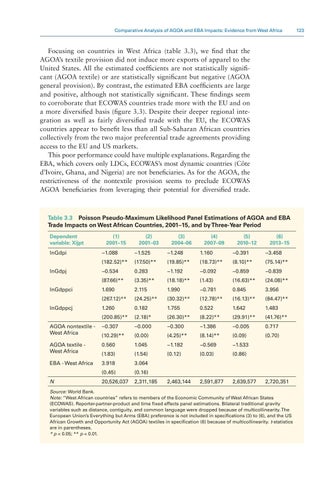Comparative Analysis of AGOA and EBA Impacts: Evidence from West Africa 123
Focusing on countries in West Africa (table 3.3), we find that the AGOA’s textile provision did not induce more exports of apparel to the United States. All the estimated coefficients are not statistically significant (AGOA textile) or are statistically significant but negative (AGOA general provision). By contrast, the estimated EBA coefficients are large and positive, although not statistically significant. These findings seem to corroborate that ECOWAS countries trade more with the EU and on a more diversified basis (figure 3.3). Despite their deeper regional integration as well as fairly diversified trade with the EU, the ECOWAS countries appear to benefit less than all Sub-Saharan African countries collectively from the two major preferential trade agreements providing access to the EU and US markets. This poor performance could have multiple explanations. Regarding the EBA, which covers only LDCs, ECOWAS’s most dynamic countries (Côte d’Ivoire, Ghana, and Nigeria) are not beneficiaries. As for the AGOA, the restrictiveness of the nontextile provision seems to preclude ECOWAS AGOA beneficiaries from leveraging their potential for diversified trade.
Table 3.3 Poisson Pseudo-Maximum Likelihood Panel Estimations of AGOA and EBA Trade Impacts on West African Countries, 2001–15, and by Three-Year Period Dependent variable: Xijpt lnGdpi lnGdpj lnGdppci lnGdppcj AGOA nontextile West Africa
(1) 2001–15
(2) 2001–03
(3) 2004–06
(4) 2007–09
(5) 2010–12
(6) 2013–15
−1.088
−1.525
−1.248
1.160
−0.391
−3.458
(182.52)**
(17.50)**
(19.85)**
(18.73)**
(8.10)**
(75.14)**
−0.534
0.283
−1.192
−0.092
−0.859
−0.839
(87.66)**
(3.35)**
(18.18)**
(1.43)
(16.63)**
(24.08)**
1.690
2.115
1.990
−0.781
0.845
3.956
(267.12)**
(24.25)**
(30.32)**
(12.78)**
(16.13)**
(84.47)**
1.260
0.182
1.755
0.522
1.642
1.483
(200.85)**
(2.18)*
(26.30)**
(8.22)**
(29.91)**
(41.76)**
−0.307
−0.000
−0.300
−1.386
−0.005
0.717
(10.29)**
(0.00)
(4.25)**
(8.14)**
(0.09)
(0.70)
AGOA textile West Africa
0.560
1.045
−1.182
−0.569
−1.533
(1.83)
(1.54)
(0.12)
(0.03)
(0.86)
EBA - West Africa
3.918
3.064
(0.45)
(0.16)
20,526,037
2,311,185
2,463,144
2,591,877
2,639,577
N
2,720,351
Source: World Bank. Note: “West African countries” refers to members of the Economic Community of West African States (ECOWAS). Reporter-partner-product and time fixed effects panel estimations. Bilateral traditional gravity variables such as distance, contiguity, and common language were dropped because of multicollinearity. The European Union’s Everything but Arms (EBA) preference is not included in specifications (3) to (6), and the US African Growth and Opportunity Act (AGOA) textiles in specification (6) because of multicollinearity. t-statistics are in parentheses. * p < 0.05; ** p < 0.01.


